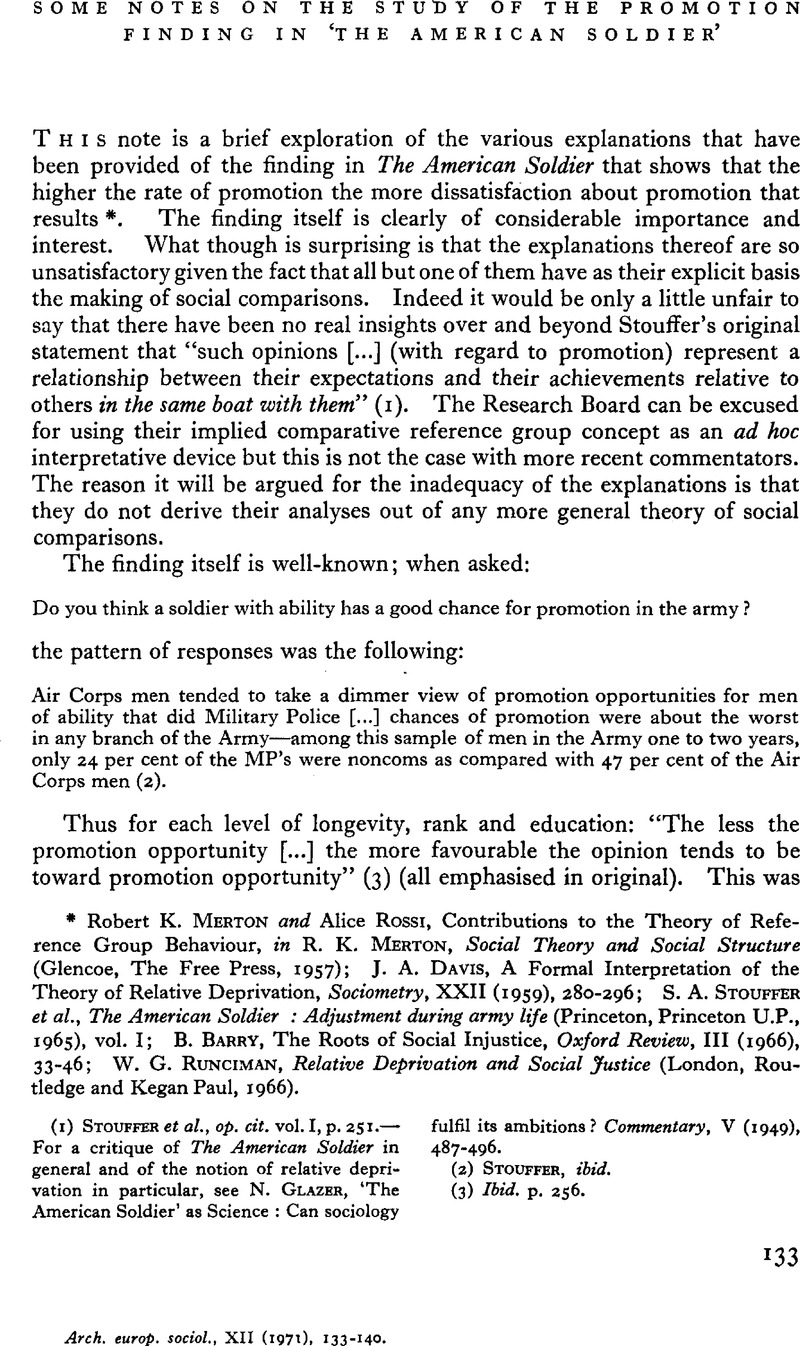Published online by Cambridge University Press: 28 July 2009

* Merton, Robert K. and Rossi, Alice, Contributions to the Theory of Reference Group Behaviour, in Merton, R. K., Social Theory and Social Structure (Glencoe, The Free Press, 1957)Google Scholar; Davis, J. A., A Formal Interpretation of the Theory of Relative Deprivation, Sociometry, XXII (1959), 280–296CrossRefGoogle Scholar; Stouffer, S. A. et al. , The American Soldier: Adjustment during army life (Princeton, Princeton U.P., 1965), vol. IGoogle Scholar; Barry, B., The Roots of Social Injustice, Oxford Review, III (1966), 33–46Google Scholar; Runciman, W. G., Relative Deprivation and Social Justice (London, Routledge and Kegan Paul, 1966)Google Scholar.
(1) Stouffer, et al. , op. cit. vol. I, p. 251Google Scholar.— For a critique of The American Soldier in general and of the notion of relative deprivation in particular, see Glazer, N., ‘The American Soldier’ as Science: Can sociology fulfil its ambitions? Commentary, V (1949), 487–496Google Scholar.
(2) Stouffer, ibid.
(3) Ibid. p. 256.
(4) Stouffer, , op. cit. pp. 254–258Google Scholar.
(5) The latter point is refuted by the fact that the morale in the AC was among the highest in the whole army; see Stouffer, op. cit. p. 253Google Scholar and chap. VII.
(6) See Merton, and Rossi, , op. cit. pp. 225–280, 236–241Google Scholar.
(7) Ibid. p. 237.
(8) See Bahry, , op. cit. p. 37Google Scholar.
(9) Runciman, , op. cit. p. 18Google Scholar.
(10) See Barry, , op. cit. p. 38Google Scholar.
(11) Runciman, , op. cit. p. 19Google Scholar.
(12) Thus of those with some high school or grade education who had been promoted, 58 % in the MP and 30 % in the AC thought that a soldier with ability had a very good chance of promotion.
(13) Barry, , op. cit. p. 39Google Scholar.
(14) See ibid. p. 39; on the nature of this curvilinear relationship see Merton, and Rossi, , op. cit. p. 236Google Scholar; and Runciman, , op. cit. p. 20Google Scholar.
(15) See Runciman, , op. cit. p. 10Google Scholar.
(16) See Davis, loc. cit.
(17) Ibid. p. 292.
(18) See fn. 5.
(19) Davis, , op. cit. p. 282Google Scholar.
(20) Ibid. p. 284.
(21) Barry, , op. cit. p. 43Google Scholar.
(22) Again see fn. 5.
(23) Barry, , op. cit. p. 46Google Scholar.
(24) This was argued in a private communication to the author.
(25) Barry, , op. cit. p. 44Google Scholar.
(26) See ibid. p. 45.
(27) See Blau, P. M., Exchange and Power in Social Life (New York, Wiley, 1964), p. 160Google Scholar; and Homans, G. C., Social Behaviour: its elementary forms (London, Routledge and Kegan Paul, 1961), p. 270Google Scholar.